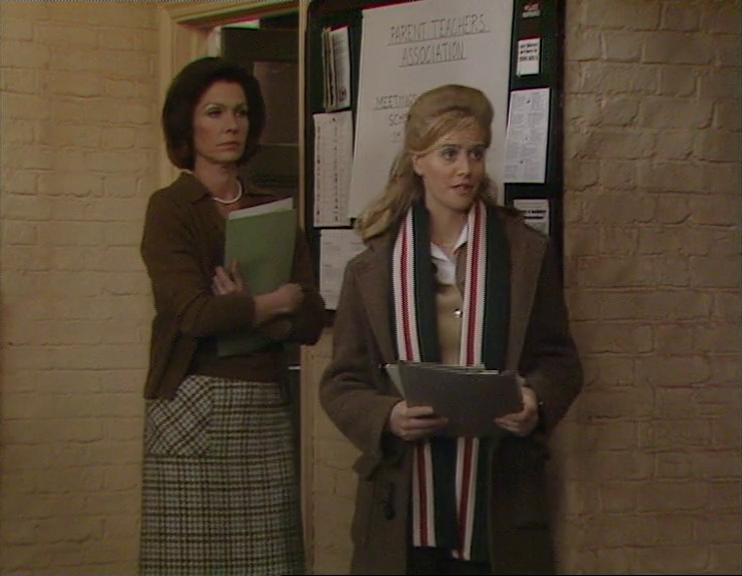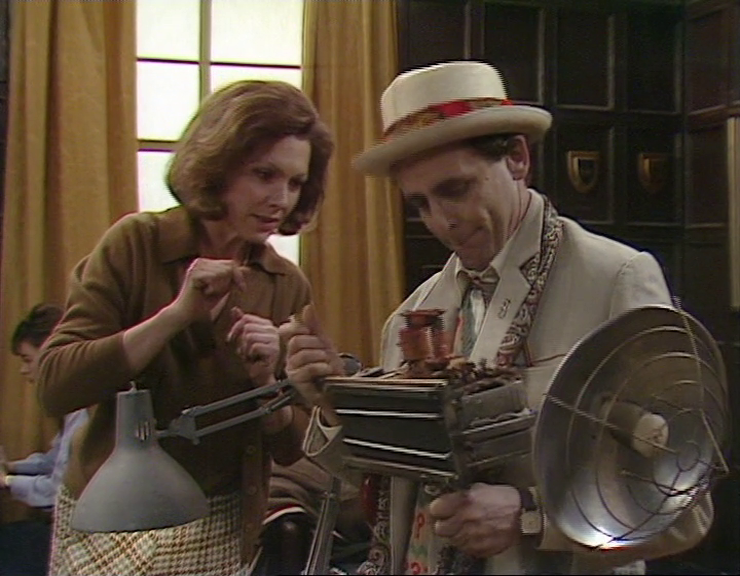'I don't have a career, I just go to work' - Rachel Jensen, the brilliant, lonely scientist
posted February 28th 2024
I've had three quarters of this essay written for months now, but this week it felt only right to finally finish it following the sad news of Pamela Salem's death. This one is dedicated to a legend 💙
One of the most iconic Doctor Who episodes of all time is Remembrance of the Daleks, and justly so - it is very good. It also introduces us to the Intrusion Counter-Measures Group, and despite being the only TV episode these characters ever appear in, Big Finish has given them the full spin-off character treatment by producing seven series worth of audio stories[1]. What is perhaps most notable about this series, and even about Remembrance itself are Professor Rachel Jensen and Doctor Allison Williams as characters who transcend the period-typical presentation of female scientists. Here, I will be looking specifically at Rachel and how extraordinary she is, especially considering the context she was concieved in and written to exist in.

It was only in 1948 that the University of Cambridge started awarding full degrees to women, and until 1987 the number of women who could study for undergraduate degrees was capped at 20%[2]. And this was only the administrative red tape - Professor Jocelyn Bell Burnell who discovered the pulsar as a PhD student at Cambridge in 1967 has given numberous talks about how she was heckled by her all-male cohort as a student, and how the only function she seemed to serve in interviews after her discovery, despite having proven her scientific worth, was as the 'human interest' because she was 'a young woman and never mind what came after that'[3]. Fortunately, the culture of science continues to change and Professor Bell Burnell is today widely regarded as a pivotal figure in the scientific world. However, this cannot diminish the struggle that being a working woman in science faced in the 60s.
It would have been easy, then, for the concept of Counter-Measures to have Rachel and Allison constantly struggling against the society they live in and showing them fight to be heard in a field where neither of them are really wanted. They could so easily have served as femininst icons - especially given that they were written in the 1988 as third-wave feminism was about to begin. The contemporary audience would have been unlikely to find two working female scientists too unusual, but what really interests me is the way that Remembrance is set in 1963. As discussed, the episode could have made their entire story about shouting to be heard, but instead it allows them to be respected and listened to for their scientific insight, something which is furthered in the audios.
A modern audience may expect to see some feminist discussion in a series like Counter-Measures, but to be constantly reminded of the negative impacts of 60s sexism would grow tiring very quickly. Indeed, C-M does touch on these issues - it is particularly evident in episodes such as The Pelage Project where Rachel finds out she was 'second choice' for scientific advisor, and where her cover role has to be as Toby's secretary. The joy, of course, of that episode is that she does such a terrible job of it that she is outed as Professor Jensen, renowned scientist. It is this that makes Rachel so unique - she is brilliant and not only does the text tell us, but it allows everyone around her to truly believe it too. Not only this, but it allows Rachel to exist in a world where she is not the sole woman. In Steinke's [research on flim lady scientists, she notes that] of all the films viewed for the study, none of them 'showed more than one female scientist or engineer as part of a research team, but several of the films showed two or more male scientists or engineers as part of a research team.'[4] The very fact that both Rachel and Allison are working together allows them to have a unique dynamic that is still very rarely seen in SF because it lets them be people instead of women who have to prove their place among a male team.
Rachel herself, though, does at first glance seem to be the stereotype of a female scientist: she is dedicated to her job above all else, she is assertive in a way that is almost off-putting, is intelligent almost beyond belief, and has a sense of independence that . Flicker[5] identifies six archetypes of female scientists in film in her analysis - of these, the Male Woman and the Lonely Heroine. The Male Woman is defined as:
A member of a male team [who] “stands up for herself.” She has learned to be assertive within a male environment, has a rough, harsh voice, dresses practically and from time to time succumbs to an unhealthy lifestyle [...] This female character is put together in a way very similar to the character of the male scientist. [...] Related to her scientific competence, she is inferior to her male colleagues. She also cannot be taken seriously as a woman as she is missing female charm.
and the Lonely Heroine as:
The most competent scientist in her special area. She is a modern, emancipated woman. She finds it natural to move within a male environment, and accordingly she also has appropriated some male traits. Her greatest (or only) interest is in her scientific research. [She has] an insatiable curiosity, job as a calling, moral integrity, modesty, strong belief in visions [...] Nonetheless, she is still lacking something: professional recognition by those in power and the right lobbying, which her male counterparts deny her. Thus she remains in a restrictive situation, dependent on financial support and political and social recognition.
If Counter-Measures was concerned with gritty realism, it's certain that Rachel would fully embody the Lonely Heroine, fighting against her male-dominated world in order to be heard. However, C-M subverts the usual picture of the lonely career woman surrounded by men and populates its universe with an unrealistic but delightful number of female scientists, all of whom are distinct from each other and who are allowed to interact with each other as scientists and people, not as women competing against each other for the recognition or affections of a man, something which happens devastatingly often in SF. The closest C-M comes to Rachel competing against another female scientist is in The Fifth Citadel when she and Toby encounter Dr Elizabeth Bradley, one of Toby's old friends. Even here when they are distrustful of each other, it is more that they are trying to judge each other's motives and choices than trying to prove anything at all to Toby or fighting for his attention. Indeed, he is already more than aware of their worth and crucially respects them both as authorities in their fields. Frequently, he tells Rachel how much he values her scientific insight, something echoed by Ian who does not question her ability as the scientific leader of the team, even when he is upset with her usurping him. Because she is free from having to prove herself as an authority, she is able to interact with the story as a person rather than as only a female scientist fighting for recognition.
This allows Rachel to exist as a woman who sees her 'job as a calling' and still break away from being the Lonely Heroine her because she is not the singular female scientist in the entire world of C-M, and is not hostile to other women because they aren't threats to either her career or personal life. Her relationship with Allison also reduces the feeling of loneliness because their friendship is close and affectionate, something that is very rare to see between fictional female scientists, or indeed even at all between women in SF. They are both valued as scientists by their team and by the wider world, so they are able to have conversations and conflicts that aren't to do with tearing each other down. Because their friendship is demonstrably real, proven by the amount of times they stay at each other's houses and go out for dinner among other things, Rachel can be insular about her work but not feel lonely - in fact, the opposite because she has people who she can share her work with who care about and rely on her passions.

Rachel is also able to break away from being the Male Woman because of her friendships with her team. Despite the fact that she is assertive and practical and has no interest in relationships beyond the platonic, she is not seen as 'lesser' as a woman for this. In Remembrance, her style is very proper for a woman of the period, even to the point of looking old-fashioned against Allison's more modern trousers and duffle coat. This does not, however, ever serves to undermine Rachel's position as the leader. She is never judged for the decisions she makes in her personal life, even in episodes such as The Splintered Man and Manhunt where her lack of romantic partnership is drawn attention to. In these episodes, it is commented on, but crucially it is framed by the narrative not as a disappointment or failure, but as the right thing for her to have done for the way she wants to live her life. She is allowed to see it not as a regret that she doesn't have a family, but simply as a course her life did not take.
And, indeed, she does have a family of sorts in the ICMG. "We're all the family we have," Toby says in The Dead Don't Rise, and he is right - although Rachel would argue that she doesn't have or need a life outside of science, that's blatantly untrue. Even from the first episode, she is staying with Allison, and as the series progresses we get to learn of her other scientific collegues, students, and friends, and she is constantly going out for dinner with Ian and Allison. She does have a life, it just defies what should have been expected of her. And, if anything, that is why she has to leave in The Dalek Gambit, because the ICMG is becoming too obtrusive, giving her too much life outside of her one true passion. And despite the fact that, as a listener, her choice upsets me, it does make sense narratively, because at the end of the day, Rachel Jensen is synoymous with science, and she must do whatever it takes to persue that.